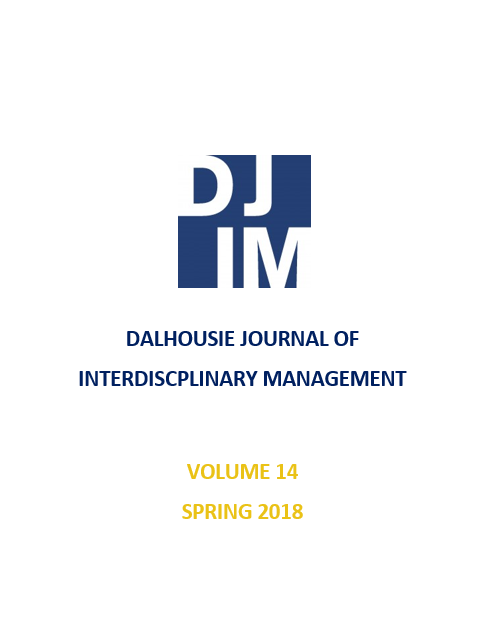Mortgage Lending and Borrowing Regulatory Changes
DOI:
https://doi.org/10.5931/djim.v14i0.7871Keywords:
Government, Housing, Economy, Regulation, Mortgage, LendingAbstract
Prices in Vancouver and Toronto housing markets are forcing a tightening of mortgage lending across Canada by the Office of the Superintendent of Financial Institutions (OSFI). This form of risk mitigation is carried out through increased stress testing of mortgage borrower income levels along with more strictly enforced loan-to-value requirements used to regulate lending practices by Federally Regulated Financial Institutions (FRFIs).
The goal of the tightened mortgage lending is due to concerns surrounding the increasingly alarming debt problem as Canadian debt to income levels doubled in the past two decades, along with historical drops in Debt-Service ratios of Canadians during economic downturn. With Canadian debt to income levels at an all-time high, coupled with the facts that the current Canadian rates are higher than those of the US prior to the 2008 Financial Crisis, and the high level of mortgage debt that makes up the overall debt of Canadians, tightening of mortgage regulation is something that the Government deems necessary.
Written in the format of a Memorandum to a Deputy Minister in the Federal Canadian Government, this paper examines and addresses key issues related to the increased mortgage regulation being carried out by OSFI and the Federal Government.
References
Bates, L. J., & Santerre, R. E. (2016). The Market Demand Characteristics Associated with Real Estate
Canadian Mortgage and Housing Corporation. (2016, July). CHS: Mortgage Lending 2015.
Docking, D. S. (2011). The 2008 financial crises and implications of the Dodd-Frank Act. Journal of Corporate Treasury Management, 4(4), 353-363.
Gellatly, G., & Morissette, R. (2017) Non-resident Ownership of Residential Properties in Toronto and Vancouver: Initial Information from the Canadian Housing Statistics Program, Statistics Canada – Analytical Studies Branch. Retrieved from: http://www.statcan.gc.ca/pub/11-626-x/11-626-x2017078-eng.htm
Housing and Market Information. Retrieved from https://www.cmhc-schl.gc.ca/odpub/esub/64687/64687_2016_A01.pdf?fr=1511145103591
Jang, B. (2017, January 16). 2016 was a record-setting year for Canada‘s housing market. The Globe and Mail. Retrieved from: https://www.theglobeandmail.com/report-on-business/2016-was-a-record-setting-year-for-canadas-housing-market/article33640396/
Liu, R., Hui, E., Lv, J., & Chen, Y. (2016). What Drives Housing Markets: Fundamentals or Bubbles? Journal of Real Estate Finance & Economics, 55: 395-415.
MarketLine. (2016, June 30). Toronto - City Profile. Retrieved from http://advantage.marketline.com.ezproxy.library.dal.ca/Product?ptype=Cities&pid=ER0046CP
MarketLine. (2016, September 8). Vancouver - City Profile. Retrieved from http://advantage.marketline.com.ezproxy.library.dal.ca/Product?ptype=Cities&pid=ER0047CP
Office of the Superintendent of Financial Institutions. (2013, January). Corporate Governance. Retrieved from http://www.osfi-bsif.gc.ca/Eng/fi-if/rg-ro/gdn-ort/gl-ld/Pages/CG_Guideline.aspx
Office of the Superintendent of Financial Institutions. (2017, October). OSFI is reinforcing a strong and prudent regulatory regime for residential mortgage underwriting. Retrieved from http://www.osfi-bsif.gc.ca/Eng/osfi-bsif/med/Pages/B20_dft_nr.aspx
Office of the Superintendent of Financial Institutions. (2017, October). Residential Mortgage Underwriting Practices and Procedures - effective January 1, 2018. Retrieved from http://www.osfi-bsif.gc.ca/Eng/fi-if/rg-ro/gdn-ort/gl-ld/Pages/b20_dft.aspx
RBC Economics. (2017, October 17). Canada‘s Housing Market – As expected, OSFI tightens rules for non-insured mortgages. RBC Economics. Retrieved http://www.rbc.com/economics/economic-reports/pdf/canadian-housing/housing_OSFI_Oct2017.pdf
RBC Economics. (2017, October). Home Resale and Price Forecast - October 2017. RBC Economics. Retrieved http://www.rbc.com/economics/economic-data/pdf/home-resale-fcst_can.pdf
Real Estate Board of Greater Vancouver. (February 2017). Metro Vancouver housing market off to a quieter start than last year. Retrieved from: http://www.rebgv.org/sites/default/files/2017-01-January-Stats-Package.pdf
Scotiabank Global Economics. (2017, April 20). Ontario‘s Fair Housing Plan: Multiple Measures with Uncertain Impact. Scotiabank Global Economics. Retrieved from: http://www.gbm.scotiabank.com/scpt/gbm/scotiaeconomics63/2017-04-20_I&V.pdf
Services: Some Evidence from a Panel Data Set of MSAs. Journal of Real Estate Finance & Economics, 53: 77-89.
Sirmans, C. S., Smith, S. D., & Sirmans, G. S. (2015). Determinants of Mortgage Interest Rates: Treasuries versus Swaps. Journal of Real Estate Finance & Economics, 50;34-51.
Spiegel, M. (2011, June). The Academic Analysis of the 2008 Financial Crisis: Round 1. Review Of Financial Studies. 24(6):1773-1781
Statistics Canada. (n.d.). Canadian Housing Statistics Program, CANSIM (database). Retrieved March 2, 2018, from: http://www.statcan.gc.ca/daily-quotidien/171219/dq171219beng.htm?HPA=1
Statistics Canada. (n.d.). Table 027-0008 - Canada Mortgage and Housing Corporation, housing starts, under construction and completions, all areas, CANSIM (database). Retrieved March 2, 2018, from: http://www5.statcan.gc.ca/cansim/a26?lang=eng&retrLang=eng&id=0270008&&pattern=&stByVal=1&p1=1&p2=37&tabMode=dataTable&csid=
Statistics Canada. (n.d.). Table 378-0123 - National Balance Sheet Accounts, financial indicators, households and non-profit institutions serving households, quarterly (percent), CANSIM (database). Retrieved December 5, 2017, from: ttp://www5.statcan.gc.ca/cansim/a26?lang=eng&retrLang=eng&id=3780123&&pattern=&stByVal=1&p1=1&p2=31&tabMode=dataTable&csid
Statistics Canada. (n.d.). Table 379-0031 - Gross domestic product (GDP at basic prices, by North American Classification System (NAICS), CANSIM (database). Retrieved March 2, 2018, from: http://www5.statcan.gc.ca/cansim/a37
Statistics Canada. (n.d.). Table 380-0073 - Selected indicators - Households, quarterly (dollars unless otherwise noted), CANSIM (database). Retrieved from: http://www5.statcan.gc.ca/cansim/a26?lang=eng&id=3800073
TD Economics. (2013, July 16). Canadian households more indebted than U.S. Households, but only after the recent U.S. deleveraging. TD Economics. Retrieved from https://www.td.com/document/PDF/economics/special/CanadianHouseholdDebt.pdf
Toronto Real Estate Board. (October 2017). TREB Housing Market Charts – October 2017. Retrieved from http://www.trebhome.com/market_news/housing_charts/index.htm
Trading Economics. (n.d.). Canada Interest Rate. Retrieved December 5, 2017, from https://tradingeconomics.com/canada/interest-rate
Trading Economics. (n.d.). Canada Unemployment Rate. Retrieved December 5, 2017, from https://tradingeconomics.com/canada/unemployment-rate
Downloads
Published
Issue
Section
License
Papers published in the Dalhousie Journal of Interdisciplinary Management must be the original, unpublished work of the author. Contributors are responsible for obtaining any copyright clearances required in relation to their work.
Authors submitting a paper to the Dalhousie Journal of Interdisciplinary Management automatically agree to grant a limited license to DJIM if and when the manuscript is accepted for publication. This license gives permission for DJIM to publish the paper in a given issue and to maintain the work in the electronic journal archive. DJIM also submits issues to institutional repositories and Open Access repositories.
Contributors agree to each reader accessing, downloading, or printing one copy of their article for their own personal use or research. All other copyrights remain with the author, subject to the requirements that any republication of the work be accompanied by an acknowledgement that the work was first published in the Dalhousie Journal of Interdisciplinary Management and that the DJIM Editorial Chair must be notified of any republication of a work first published in DJIM.
Dalhousie Journal of Interdisciplinary Management
c/o School of Information Management
Faculty of Management
Dalhousie University
Kenneth C. Rowe Management Building
6100 University Avenue
Halifax, Nova Scotia B3H 3J5
Canada
Email: djim@dal.ca
Authors should recognize that, because of the nature of the Internet, the publisher has no control over unauthorized copying or editing of protected works.


